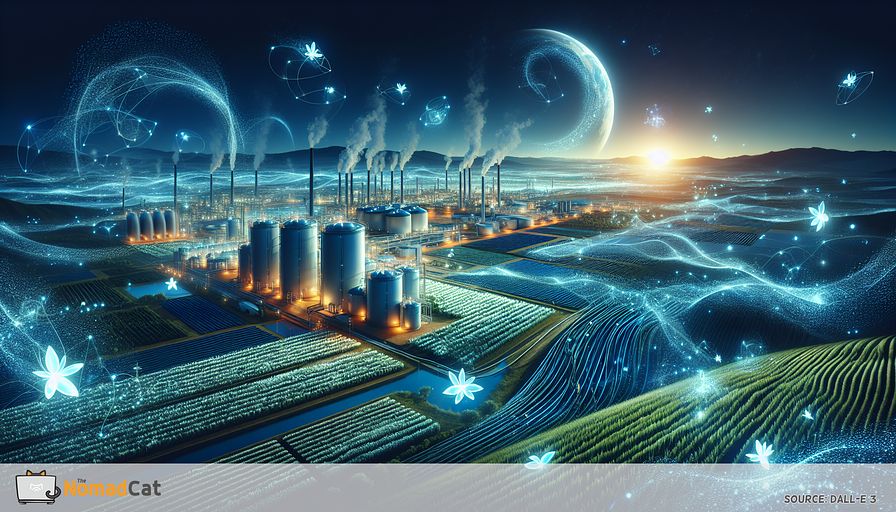Abstract:
The Chief Technology Officer highlights the potential of algae biofuels in addressing the global energy crisis and reducing carbon footprint. Algae can produce biofuels without competing with agricultural land or freshwater resources and can yield up to 30 times more oil per acre than traditional crops. The team is working on optimizing algal biofuel technology, focusing on growth conditions, genetic engineering, and refining processing techniques with sustainability and efficiency in mind. The goal is to create a scalable and sustainable biofuel production solution to transition towards a greener future.
algae biofuels and the urgent need for sustainable solutions
As the world faces an escalating energy crisis, the search for sustainable fuel solutions has never been more critical—or urgent. We need to think outside the proverbial barrel of oil and explore innovative alternatives that can meet our energy demands while also addressing environmental concerns. Enter algae biofuels: a fascinating and promising option that could revolutionize the way we power our lives and industries.
Algae biofuels present an alluring opportunity in the quest for renewable energy. Unlike traditional fossil fuels, which pump out staggering amounts of carbon emissions, algae have the potential to drastically cut down our carbon footprint. These tiny, green powerhouses harness sunlight and convert carbon dioxide into energy, effectively serving as nature's own little biofuel factories.
Let's face it—to tackle climate change effectively, we need a multifaceted approach. Algae biofuels tick many of the right boxes. They're renewable, can be produced in large quantities, and they don't require valuable arable land that could otherwise be used for food production. This means algae biofuels don't have to elbow our food supply out of the way, a common criticism thrown at other biofuel sources like corn and soy.
In my professional journey, I've always been captivated by technological solutions that offer a greener future. Algae biofuels are genuinely one of those innovations that could make a tangible difference. Their potential to provide a significant portion of our energy needs while simultaneously reducing our impact on the environment is incredibly exciting. By optimizing algae cultivation and biofuel production technologies, we stand on the cusp of a sustainable energy revolution—one algal cell at a time.
algae as a non-competitive resource
When it comes to biofuels, one of the lingering issues has been the competition for resources—particularly land and water—that could otherwise be used for food production. This concern has often cast a shadow over the biofuel industry, but algae biofuels offer a glimmer of hope. Algae are a game-changer precisely because they don't require fertile agricultural land or an abundance of freshwater to thrive. Instead, they can be cultivated in places where other crops would fail miserably, like saltwater or wastewater environments.
Think about it: traditional biofuel crops like corn and soy are often grown on prime agricultural land, leading to debates over "food vs. fuel." Algae, on the other hand, can be grown in bioreactors set up in non-arable areas, meaning they're not elbowing out food crops for space. This is a massive advantage, especially in a world where arable land is a limited and precious resource.
incredible yield potential
Now, if the land issue wasn't convincing enough, let's talk numbers. Algae can produce up to 30 times more oil per acre than traditional crops like soybeans or corn. Yes, you read that right—30 times more! This remarkable yield potential makes algae not just a cleaner alternative but a more efficient one as well. Picture a tiny algae cell that's 30 times more productive than an ear of corn, efficiently churning out biofuel while using a fraction of the space. Impressive, right? Some might even say it's like comparing a marathon runner to a leisurely stroller when it comes to efficiency and output.
biological and environmental factors
Let's get a bit nerdy with the science behind this. Algae are photosynthetic organisms, meaning they convert sunlight into energy through photosynthesis. This is the same process that plants use, but algae do it with far greater efficiency. Furthermore, algae can grow in a variety of conditions that would be hostile to other plants. Whether it's high salinity, extreme temperatures, or nutrient-poor environments, these little green warriors can withstand and flourish where others falter. This resilience not only makes algae a versatile candidate for biofuel production but also reduces the need for valuable resources such as freshwater and fertilizers.
In my career, I've always been fascinated by the ingenious ways we can repurpose what the natural world offers us. Algae biofuels stand out as one of those innovations where nature and technology really get to shine together. By harnessing algae's capability to produce high yields without demanding critical agricultural resources, we're making a substantial leap toward creating a sustainable and eco-friendly energy solution. Imagine fields of algae, quietly yet efficiently working away to provide us with fuel—not from a precious piece of farmland but perhaps from an unused desert patch or a tankful of briny water. It's sustainable ingenuity at its best.
optimizing algal biofuel technology
Advancements in algal biofuel technology are driving us closer to a more sustainable future, one where the reliance on fossil fuels takes a significant backseat. The journey to optimize algal biofuel involves a multifaceted approach, honing in on various avenues such as refining growth conditions, employing genetic engineering, and innovating processing techniques.
perfecting growth conditions
To maximize the efficiency and yield of algae, dialing in the ideal growth conditions is a critical component. From ensuring the right mix of nutrients to optimizing light exposure, these factors play a significant role in the productivity of our little green powerhouses.
One of our team’s coolest breakthroughs involves creating optimal light conditions. We’ve tinkered with everything from LED lighting setups to reflective surfaces in the cultivation tanks. This is where a bit of humor comes in—imagine us as modern-day sun gods, tweaking the daylight hours to boost our algae crops! The result: a healthier, more productive algal bloom that's ready to be transformed into biofuel.
genetic engineering: turbocharging efficiency
Genetic engineering stands as a fascinating frontier in optimizing algae for biofuel production. By tweaking the genetic makeup of algae, scientists can significantly enhance attributes such as growth rate, lipid content (which translates to more oil), and resilience to adverse conditions.
Picture this: our team in lab coats, hunched over microscopes, passionately debating the merits of the latest CRISPR techniques like they're the next big thing in movie plots. These efforts aren't just for show. Engineer algae strains that can yield higher oil content without requiring extensive resources is a practical pursuit. I’m reminded of a discussion we had over coffee once, where one of our lead researchers said, "If you can make algae act like a super-organism, why wouldn't you?" It's that kind of forward-thinking that drives our genetic engineering initiatives.
innovations in processing techniques
Processing algae into biofuel efficiently and sustainably is another crucial element. Algae may be grown in a renewable manner, but if the processing techniques are energy-intensive, it diminishes the overall benefits. Fortunately, we've made strides in this area too.
Imagine extracting oil from algae without breaking the bank—or the environment. New methods, such as hydrothermal liquefaction and supercritical CO2 extraction, are showing great promise. These techniques minimize energy consumption and maximize yield, aligning perfectly with our sustainable goals. I recall a particularly joyful experiment where we managed to extract biofuel in a record time, leading to a team-wide "Eureka!" moment. Yes, we did a little victorious dance in the lab that day.
Our lab isn't just a place of serious experimentation; it's also where collaboration flourishes. We've formed partnerships with leading universities and research institutions to bolster our technological arsenal. These collaborations have been instrumental in pushing the limits of what we can achieve with algae biofuels.
the road ahead
The journey toward making algae biofuels a mainstream energy source is undoubtedly exciting. Each new discovery feels like piecing together a giant jigsaw puzzle. With every advancement, whether in growing conditions, genetic engineering, or processing techniques, we come closer to an efficient and scalable solution.
One of our objectives is to reduce the cost of biofuel production to make it competitive with, or even cheaper than, traditional fossil fuels. We’re striving to achieve what may seem like the holy grail of renewable energy—a fuel that is both eco-friendly and economically viable. Our team's hard work isn't just theoretical; it's aimed at making a real-world impact.
Another goal is to scale up production sustainably. It’s one thing to produce algae biofuel in a lab setting; it’s another to produce it at a scale that can meet global energy needs. We’re actively exploring large-scale bioreactor designs and innovative farming techniques to bring this vision closer to reality.
Our team’s dedication and innovative spirit are truly the driving force behind these advancements. From late-night brainstorming sessions to "aha" moments in the lab, our collective passion for a greener future keeps us motivated. It's this enthusiasm that leads me to believe that algae biofuels hold incredible promise. As we continue to optimize and scale up, I am confident that algae can indeed power a more sustainable world—one algal cell at a time.














